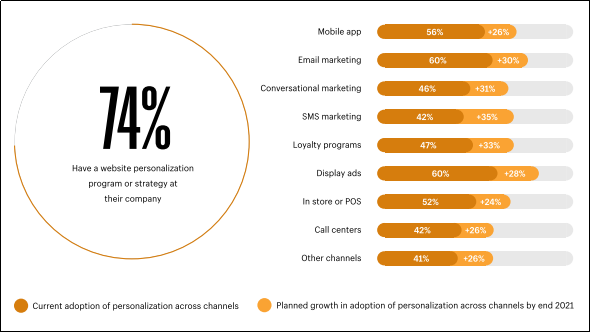Seven New Trends to alter Ecommerce’s Future in 2021
Are you ready for a tech-savvy future?
Well, there are a few things we didn’t see coming, such as the economic and health crises, followed by the pandemic, but the digital revolution is not one of them. We were always certain about it! The silver lining we all saw in the appearance of increased eCommerce is something to be grateful for.
Ecommerce is a behemoth of a business. It’s the reason why people are interested in the future of ecommerce.
Global ecommerce sales are expanding these days, demonstrating that ecommerce is becoming a more profitable alternative for businesses. It had increased from 1336 billion U.S. Dollars in 2014 to 4280 billion U.S. Dollars in 2020.
| Characteristic | Sales in billion U.S. dollars |
| 2014 | 1,336 |
| 2015 | 1,548 |
| 2016 | 1,845 |
| 2017 | 2,382 |
| 2018 | 2,982 |
| 2019 | 3,354 |
| 2020 | 4,280 |
Nowadays, the world is shaping up like something which we had never seen before. Hence, most eCommerce organizations shattered their predictive powers and tossed aside their demand projections in February 2020. Although the uncertainty persists, we may now use it to identify trends and make predictions for 2021.
The global economy is still shaky and recovering, but that doesn’t mean we can’t learn! Like every year, there are trends to watch and things to plan for in the new year. In that vein, here is a forecast for global eCommerce trends in 2021.
Let’s dive in.
- Pay Later When You Buy Now
A growth in “buy now, pay later” alternatives is anticipated to be one of the most popular eCommerce trends in the coming year. This may appear to be a credit arrangement at first sight, but it works a little differently. For example, people with lesser monthly earnings might use these methods to achieve larger purchases.
When a person decides to buy a new exercise bike, they may not afford it upfront. Buying now and paying later will allow consumers to divide the payment over a few months. They pay tiny monthly instalments that appear more reasonable, and the corporation receives their sale. A win-win situation for everyone.
- Augmented Reality in Online Shopping Will Become Benchmark
What was formerly considered a “nice to have” feature is becoming more popular in internet retailers? Because it eliminates the uncertainty of not trying on the merchandise, augmented reality is redefining the online purchasing experience.
Customers can now visualize how they would appear in that garment or how the coffee table would look in their living space by getting a feel for it. By 2020, AR usage on e-commerce sites had increased, and this trend is likely to continue in 2021.
- Customer Experience and Personalization
The key to winning the new e-commerce game in 2021 is to personalize the customer experience as much as possible. Good consumer experiences are valued and remembered.
On-site customization can boost income while lowering bounce rates. In addition, engagement and conversions can be increased by strategies such as serving the customer in their chosen channel and employing AI-powered solutions to provide tailored adverts.

- Real deal will be UX
Even the most averse to technology began to investigate digital consumer life. People have learned to live, shop, and converse online over the last year. The Gen Zs and Millennials, and the baby boomers are experimenting with video meetings, online grocery shopping, and other internet activities.
People are now looking for an amazing user experience (UX). They’ll be less tolerant of digital flaws and complicated user interfaces. Brands must prepare their technologies and user experiences to keep their newfound customers.
- Use of Conversational Technology Is Increasing
According to Gartner, the usage of conversational AI will increase by more than 100% by 2025. As a result, voice technology (Alexa, Google Home) is becoming more popular among consumers for searching and shopping. Alexa Voice Shopping, for example, allows you to order and finish items using voice commands.

You may tell your voice assistant whether you’re out of eggs, napkins or want to order food. The device retains your payment information and even previous purchases.
- Social Shopping Become Popular
It’s a fact that most people spend a significant amount of time on their phones daily. Then it feels natural to use the phone to make purchases. However, when done correctly, buying from your phone delivers the utmost convenience. Therefore, it’s crucial to have a user-friendly design and a simple checkout process.

Platforms like Facebook (and Instagram) take advantage of these opportunities by providing SMEs with services like Facebook and Instagram Shops and in-ad transactions. It’s no wonder, then, that m-commerce will continue to increase in the coming years.
- Combining Brick-and-Mortar and eCommerce
In the past, eCommerce and brick-and-mortar sales were opposed. Even if a company offered both options, the transactions never happened at the same time. However, the distinction between online and in-person buying is becoming increasingly blurred.
To improve their consumers’ shopping experience, some companies are increasingly offering in-store eCommerce choices. For example, shoppers can pick up their desired items and then scan them into an app on their phones. Then, instead of waiting in line to make their purchase, consumers can check out using the app whenever they’re ready.
To summarize,
Trends in eCommerce had advanced at a rapid rate in 2020 due to the pandemic. And it’s conceivable that the modifications described above will become unavoidable by the end of 2021. However, future eCommerce trends will remain turbulent if consumers become accustomed to new shopping methods. If people aren’t back on the streets and in stores, the year 2021 will remain hazy. Although eCommerce adoption is unstoppable, a shift in customer preferences is unavoidable!
Start preparing to seize the opportunity and make the required adjustments now to keep your eCommerce business competitive. There is less time to wait, and if you aren’t at least thinking about adjusting to a few of these trends, you’ll soon find yourself behind the times.
Author bio: Karen Hamada is a professional blogger and academic content writer at a reputable organization in the UK. She has been working as an independent essay Help and Assignment Help for decades and has had his works published in the top magazines like Forbes, The Telegraph, and the English Heritage Member’s Magazine.




